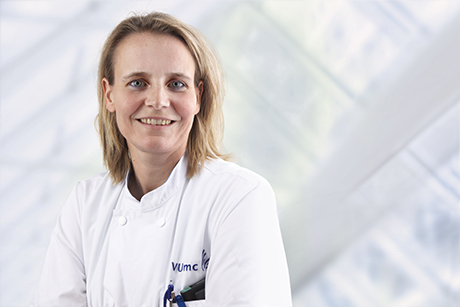“PET-imaging can be really valuable for clinical practice for several rheumatic diseases in the near future”
Conny van der Laken is a rheumatologist and a principal investigator of advanced imaging studies in rheumatology at the University of Amsterdam. Within the Immune-Image project, she is leader of Task 6.5, in a work package linked to patient research. Her research group will test new immuno tracers for monitoring rheumatoid arthritis treatment. We interviewed Dr. van der Laken about this clinical trial, that was the first one to start within the Immune-Image project, and the expectations and challenges of this new imaging technique.

Identification of important immunological targets
Within Dr. van der Laken’s research, the main focus lies on PET-imaging. Besides her role as work package leader, she is also involved in WP 4 and 5 where her focus lies on the pre-clinical development and evaluation of new immuno tracers for rheumatoid arthritis. Within Task 6.5 she is doing research related to the development and monitoring of new immunotargets in rheumatoid arthritis. “We identify important immunological targets for early diagnostic and therapy monitoring in rheumatic diseases. Then we look whether or a not there is a PET-tracer available for this specific target of interest. If not, we work together with the radiochemical lab of Bert Windhorst, coordinator of the Immune-Image project, in order to develop new PET-tracers.” Conny is also involved in Task 6.6 which is closely related to what she is doing in Task 6.5. “Task 6.6 focuses on PET-imaging of large vessel vasculitis, so we work closely together with the group of Liesbeth Brouwer at UMCG. And that is where we will also expose the same immuno tracers as we investigate for rheumatoid arthritis for large vessel vasculitis.”
New imaging technique in the first clinical trial of Immune-Image
For the Immune-Image project, Dr. van der Laken and her team are developing a new imaging technique. “This technique is related to a new macrophages PET-tracer that we evaluated for therapy monitoring in rheumatoid arthritis. First, we will make a scan at the start of anti-TNF therapy in rheumatoid arthritis patients and then make a second scan four weeks after initiation of therapy. By imaging, we investigate whether we can predict later clinical outcome during the early stages of treatment. And that would be beneficial for clinical practice because nowadays we must wait at least three to four months, after initiation of biological treatment for rheumatoid arthritis, before we can assess the efficacy of the treatment.”
Predict if a treatment will be successful
Unfortunately, a part of the patients who get this new tracer will not respond to therapy. “The current trial shows that approximately 30 to 50% will not respond to this kind of therapy. It will be a great advantage if we can predict much earlier in time whether a treatment will be successful for particular patients. So, that is the focus of this trial. In the second phase of the project, we will add a second newly developed immuno tracer. This will be a feasibility trial to investigate whether this tracer is successful to image disease activity in rheumatoid arthritis patients.”
Expectations of this new tracer
Dr. van der Laken expects that clinicians can be more specific in targeting disease activity of rheumatoid arthritis. “I expect that we will get nice results in the early phase of therapy monitoring. It has a good chance of having additive value to our clinical assessments. So, that will be really helpful in the future for clinicians to make early treatment decisions.”
Next steps?
The first patients have been included in the trial, but what will be the next steps? “In the upcoming two years, of course, we need to include some more patients in this trial. We strive to include 20 patients in total. The second feasibility trial will start later on in the project. The third step might be that if new promising immune tracers evolved from the project, we might also be investigating these new tracers as well. But this is something that has to be decided by the management of the Immune-Image project at a later stage.”
Challenges of the trial
So far, the results seem promising but Dr. van der Laken foresees challenges. “When you work with new immuno PET-tracers it is never certain whether or not the tracer synthesis works out well and every time you have to prepare it for each individual patient. Since there is not a lot of experience yet with the synthesis of these tracers, things might happen along the way. In a clinical research setting tracers might fail on a day that a patient is waiting for a scan. Therefore, we always tell our patients that this can happen because it is new, innovative work. Everything must be safe, and a high standard needs to be fulfilled before we inject a new tracer in the patient. Another challenge in this project is that the patients that are included have a clinically active disease. We want to make the first PET-scan before they start their treatment. Therefore, if the scan has to be postponed or can be planned a bit later in time, sometimes the patient can no longer be included in the trial anymore: The disease became too active and we cannot postpone further initiation of the treatment. Another challenge is that we have to find eligible patients while they have to fulfil certain inclusion and exclusion criteria.”
Valuable research
Dr. van der Laken is very positive about her research and has high expectations. “In general, PET-imaging can be really valuable for clinical practice for several rheumatic diseases in the near future. This imaging technique is in the starting phase and about to be introduced in clinical practice for rheumatic diseases. I think there are huge opportunities out there to explore and the Immune-Image project can contribute to that.”
Want to stay up to date about the Immune-Image project? Subscribe to our newsletter! интернет заявки на кредит
